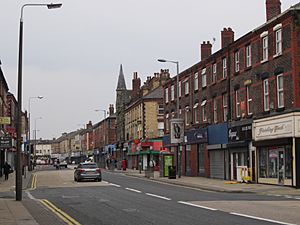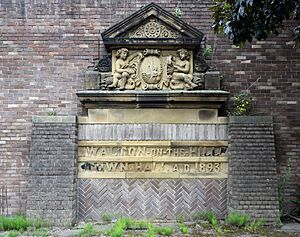Walton, Liverpool facts for kids
Quick facts for kids Walton |
|
|---|---|
 County Road, Walton |
|
| OS grid reference | SJ365945 |
| Metropolitan borough | |
| Metropolitan county | |
| Region | |
| Country | England |
| Sovereign state | United Kingdom |
| Post town | LIVERPOOL |
| Postcode district | L4, L9 |
| Dialling code | 0151 |
| Police | Merseyside |
| Fire | Merseyside |
| Ambulance | North West |
| EU Parliament | North West England |
| UK Parliament |
|
Walton is a lively area in Liverpool, England. It's located north of Anfield and east of Bootle and Orrell Park. Long ago, it was part of Lancashire. Today, Walton is mostly a place where people live, with many different kinds of families calling it home.
Contents
Walton's Past: A Look Back in Time
What's in a Name? The Meaning of Walton
The name "Walton" might come from an old word for "foreigner." The Saxons, who came to England a long time ago, called the native Celtic Britons "Walas" or "Wealas." Another idea is that it comes from "Wald tun," which means "Forest Town" in Old English.
Early Days: From Norman Times to Noble Families
Walton's story begins around 1066, when Edward the Confessor died. After the Normans took over, a powerful lord named Roger of Poitou gave Walton to his sheriff, Godfrey.
Later, in 1200, King John gave Walton to Richard de Meath. The land then passed through the de Walton family for many years. In the 15th century, it was divided among other families like the Crosse, Chorley, and Fazakerley families.
Becoming Part of Liverpool
Over time, Walton Manor was owned by different families. Finally, in 1804, it was sold to a banker from Liverpool, Thomas Leyland. Some of Walton's land also went to the Earl of Derby and the Sefton family. Walton officially became part of the Liverpool Borough Council in 1895.
Cool Places and Famous Buildings in Walton
The Old Zoo and City Farm
In 1884, the Liverpool Inner City Zoological Park and Gardens opened in Walton. It was known for its beautiful design and a famous chimpanzee named "Pongo." The zoo closed in the early 1900s. Today, the only part left is the old Ticket Booth, which is now a pizza takeaway.
Walton is also home to Rice Lane City Farm. It's a fun place to visit and is located on land that used to be a large cemetery.
Historic Pubs and Car Garages
The Prince of Wales pub on Rice Lane was once called "The Sod House" by Edward VII. He visited after seeing the zoo. People think it got this nickname because the landlord used clumps of earth, called "sods," to keep the beer barrels cool.
The old Shell garage on Rice Lane is now a used car dealership. But in the 1950s, it was the official workshop for Ferrari's race team when they competed at the Aintree Grand Prix course.
Walton Town Hall: A Piece of History Remains
Walton Town Hall was taken down in the 1960s to build the Queens Drive fly-over. However, a part of its side wall, with the name carved in stone, can still be seen today on the side of the A59 road.
Walton Hospital and Clock View Hospital
Walton was once home to Walton Hospital on Rice Lane. Many famous people from Liverpool, including Paul McCartney and Joe Fagan, were born there. The hospital was also a special center for brain and nerve care.
In 1998, these services moved to the new Walton Centre nearby. Walton Hospital started as a workhouse for the poor in the late 1800s. The cemetery next to it has many unmarked graves of people who lived there.
Today, Clock View Hospital is a modern mental health facility near the old hospital site. It opened in 2015 and has won awards for its excellent patient care and building design.
How Walton is Run: Local Government
Walton is part of the Liverpool Walton constituency. This area has often supported the Labour Party.
The current Member of Parliament (MP) for Walton is Dan Carden from the Labour Party. Most of the local councillors who represent Walton are also from the Labour Party.
Walton's Location and Unique Roads
Where is Walton?
Walton is surrounded by several other areas of Liverpool. These include Clubmoor, Anfield, Kirkdale, Norris Green, Bootle, and Orrell Park. Some of these are closer to the city center, while others are outer suburbs.
The "Ship Roads" of Walton
Walton has seven roads that locals call the "ship roads." Five of these roads are named after famous Cunard ships: Mauretania, Lusitania, Saxonia, Ivernia, and Sylvania. This is a nod to Cunard's history in Liverpool. The other two roads are Woolhope and Haggerston.
Walton's Economy and Businesses
Hartley's Village and Jam Factory
In the 1800s, Hartley's Village was built in Walton. This village provided homes for the workers from the Hartley's Jam Factory, a well-known company.
Dunlop and Cavendish Retail Park
The company Dunlop, which made molded plastics, had its main UK office and factory in Walton. This site is now the Cavendish Retail Park. In 1980, a big fire at the plant caused a lot of damage. The factory eventually closed down. Today, a Chinese restaurant and a housing estate are on the land where Dunlop once stood.
Getting Around: Transport in Walton
Roads and Railways
Walton is well-connected to Liverpool City Centre by major roads like the A59 and the A580 (East Lancashire Road).
There are two train stations in Walton on the Northern Line of the Merseyrail network. These are Rice Lane railway station and Walton railway station.
Old Railway Lines and Cycle Paths
An old railway line, the North Liverpool Extension Line, used to run through Walton. It included Warbreck railway station and Spellow railway station. Warbreck station is no longer used, but parts of it can be seen under shops. The path where the railway once ran is now a bicycle path and part of the Trans Pennine Trail.
Another old station, Walton on the Hill railway station, was near the Queens Drive flyover. Even though it closed in 1918, the line was used to transport goods to Liverpool docks through a tunnel.
What is now a bike path behind the old Hartley's and Jacobs factory used to be Fazakerley Junction, a train depot that closed in the 1960s.
Walton's Famous Football Stadium
Walton is home to Goodison Park, the football stadium for Everton Football Club. It was built in 1892 and was the first stadium in England made just for football. Everton has played there ever since. Before Goodison Park, Everton played at Anfield Stadium, which then became the home of Liverpool Football Club.
Well-Known People from Walton
Many famous people have connections to Walton:
- John Birt, a former head of the BBC, was born in Walton Hospital.
- Joe Fagan, a manager for Liverpool F.C. in the 1980s, was born in Walton Hospital.
- Gérard Houllier, a former Liverpool manager, once taught at Alsop Comprehensive.
- Brian Jacques, a children's author known for The Redwall Series, lived in Walton.
- Paul Jewell, a former football manager, grew up in Walton.
- John Melvin, a guitarist from the band The Farm, lived in Walton for many years.
- Doris Lloyd, an actress who appeared in over 150 films, was born in Walton.
- Beatle Paul McCartney was born in Walton Hospital.
- Jimmy Mulville, a comedian and TV producer, came from Walton.
- Heidi Range, a singer from the band Sugababes, was born in Walton.
- Sir Ken Robinson, an educational expert, grew up in Walton.
- Neil Robinson, a footballer for Everton F.C., was born and grew up in Walton.
- Alexei Sayle, a comedian, went to Alsop High School.
- Claire Sweeney, a TV presenter and actress, grew up in Walton.
- Ricky Tomlinson, an actor, lived in Walton in the late 1990s.
- Robert Noonan, who wrote the book The Ragged Trousered Philanthropists under the name Robert Tressell, is buried in Walton Cemetery.





